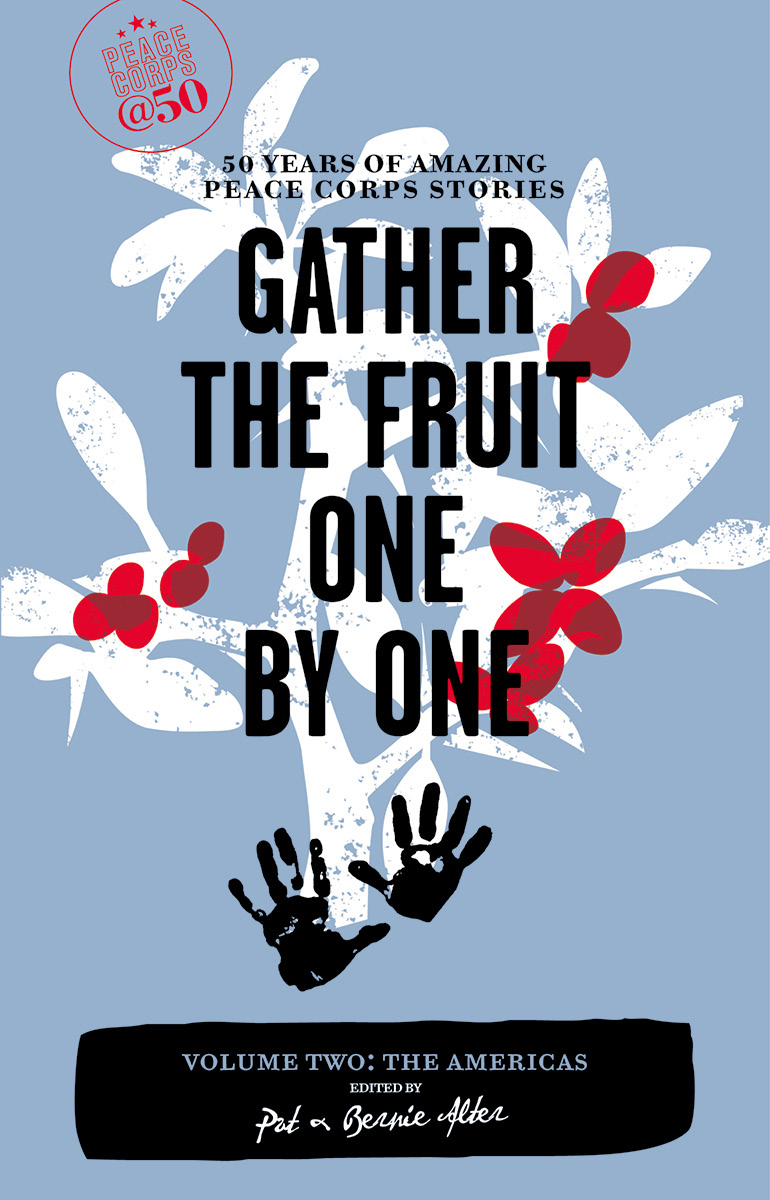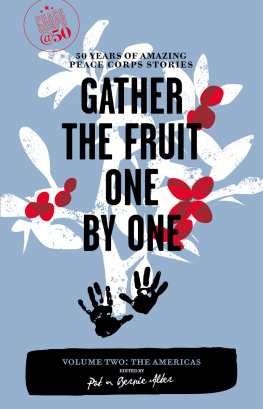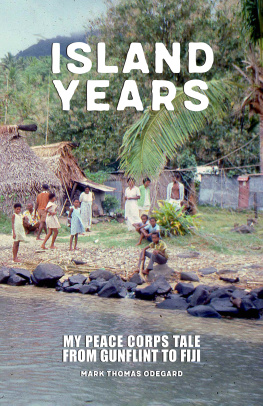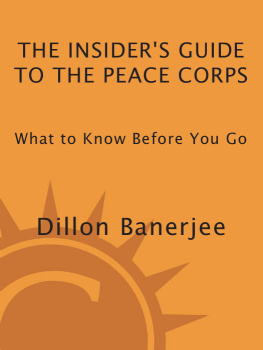

Copyright 2011 Jane Albritton. All rights reserved.
First e-book edition: June 2013
Travelers Tales and Solas House are trademarks of Solas House, Inc. 853 Alma Street, Palo Alto, California 94301. www.travelerstales.com
Cover Design: Chris Richardson
E-book Production: Howie Severson
Production Director: Susan Brady
Library of Congress Cataloging-in-Publication Data
Gather the fruit one by one : 50 years of amazing Peace Corps stories / edited by Pat and Bernie Alter. -- 1st ed.
p. cm.
ISBN 978-1-60952-001-4 (pbk.)
ISBN 978-1-60952-048-9 (ebook)
1. Peace Corps (U.S.)--History. I. Alter, Pat. II. Alter, Bernie.
HC60.5.G37 2011
361.6--dc22
2011005702
First Edition
Printed in the United States
10 9 8 7 6 5 4 3 2 1
De a uno se junta el mistal.
You must gather the fruit from the mistal tree carefully, one by one.
Table of Contents
Paul Vitale
Ecuador
Wynne Dimock
Brazil
W.W. Wales
Honduras
Maria Altobelli
Bolivia
Brandon Louie
Nicaragua
Katherine Jamieson
Guyana
Pat Alter
Paraguay
Patricia Edmisten
World
Melissa Basta
Haiti
Ronald A. Schwarz
Colombia
Larry Lihosit
Honduras
Kendra Lachniet
Paraguay
Martha Martin
Costa Rica
Sarah Hawley
Nicaragua
Richard Mortensen
Belize
Les Young
Ecuador
Sandy Elliott
Honduras
Jeff Benik
Honduras
Sara Beth Laird
St. Lucia
Matthew Dufresne
Nicaragua
Alanna Randall
Belize
Mary Nowel Quijano
Honduras
Walter James Murray
Brazil
Kyle Freund
Guatemala
Patricia Edmisten
Peru
Rafaela Castro
Brazil
Kyle Freund
Guatemala
Alan Yount
Guatemala
William M. Evensen
Peru
Patrick H. Hare
Honduras
Katherine Jamieson
Guyana
Mary Nowel Quijano
Honduras
Mark Brazaitis
Guatemala
Ellen Urbani
Guatemala
Bob Hudgens
Bolivia
Mark Brazaitis
Guatemala
Rebecca Martin
Panama
John Kotula
Honduras
Jeannette Leboyer
Paraguay
Walter James Murray
Brazil
Shane Townsend
Bolivia
Richard R. Sitler
Jamaica
Krista Perleberg
Ecuador
Amber Davis Collins
Honduras
Doris Rubenstein
Ecuador
Jessi Flynn
Panama
Janette K. Hopper
Colombia
Jessi Flynn
Panama
Series Preface
There are some baby ideas that seem to fly in by stork, without incubation between conception and birth. These magical bundles smile and say: Want me? And well before the head can weigh the merits of taking in the unsummoned arrival, the heart leaps forward and answers, Yes!
The idea for Peace Corps @ 50the anniversary media project for which this series of books is the centerpiecearrived on my mental doorstep in just this way in 2007. Four books of stories, divided by regions of the world, written by the Peace Corps Volunteers who have lived and worked there. There was time to solicit the stories, launch the website, and locate editors for each book. By 2011, the 50th anniversary of the founding of the Peace Corps, the books would be released.
The website had no sooner gone live when the stories started rolling in. And now, after four years and with a publisher able to see the promise and value of this project, here we are, ready to share more than 200 stories of our encounters with people and places far from home.
In the beginning, I had no idea what to expect from a call for stories. Now, at the other end of this journey, I have read every story, and I know what makes our big collection such a fitting tribute to the Peace Corps experience.
Peace Corps Volunteers write. We write a lot. Most of us need to, because writing is the only chance we have to say things in our native language. Functioning every day in another language takes work, and it isnt just about grammar. Its everything that isnt taughtlike when to say what depending on the context, like the intricate system of body language, and like knowing how to shift your tone depending on the company you are in. These struggles and linguistic mishaps can be frustrating and often provoke laughter, even if people are forgiving and appreciate the effort. It takes a long time to earn a sense of belonging.
And so in our quiet momentswhen we slip into a private space away from the worlds where we are guestswe write. And in these moments where we treat ourselves to our own language, thoughts flow freely. We once wrote only journals and letters; today we also text, email, and blog.
Writing helps us work through the frustrations of everyday living in cultures whereat firstwe do not know the rules or understand the values. In our own language we write out our loneliness, our fury, our joy, and our revelations. Every volunteer who has ever served writes as a personal exercise in coming to terms with an awakening ignorance. And then we write our way through it, making our new worlds part of ourselves in our own language, in our own words.
The stories in these books are the best contribution we can make to the permanent record of Peace Corps on the occasion of its 50th anniversary. And because a Volunteers attempt to explain the experience has always contained the hope that folks at home will get it, these stories are also a gift to anyone eager and curious to learn what we learned about living in places that always exceeded what we imagined them to be.
It has been an honor to receive and read these stories. Taken together, they provide a kaleidoscopic view of world culturesbeautiful and strangethat shift and rattle when held up to the light.
I would like to acknowledge personally the more than 200 Returned Volunteers who contributed to these four volumes. Without their voices, this project could not have been possible. Additionally, editors Pat and Bernie Alter, Aaron Barlow, and Jay Chen have been tireless in shepherding their stories through the publishing process and in helping me make my way through some vexing terrain along the way. Special thanks to John Coyne whose introduction sets the stage for each volume. Thanks also to Dennis Cordell for his early work on the project.
There are two people critical to the success of this project who were never Peace Corps volunteers, but who instantly grasped the significance of the project: Chris Richardson and Susan Brady.
Chris and his PushIQ team, created a visually lush, technically elegant website that was up and ready to invite contributors to join the project and to herald both the project and the anniversary itself. He took on the creative challenge of designing four distinct covers for the four volumes in this set. His work first invited our contributors and now invites our readers.
Susan Brady brought it all home. It is one thing to collect, edit, and admire four books worth of stories; it is another to get them organized, to the typesetter, the printer, and the team of marketers on time and looking good. Susans good sense, extensive publishing experience, and belief in the worthiness of this project sealed the publishing deal with Travelers Tales/Solas House.
Finally, there are the two others, one at each elbow, who kept me upright when the making of books made me weary. My motherintrepid traveler and keeper of storiesdied four months after the project launched, but she has been kind enough to hang around to see me through. My partner, cultural anthropologist Kate Browne, never let me forget that if Americans are ever going to have an honored place in this world, we need to have some clue about how the rest of it works. So get with it, they said. The 50th anniversary happens only once.










